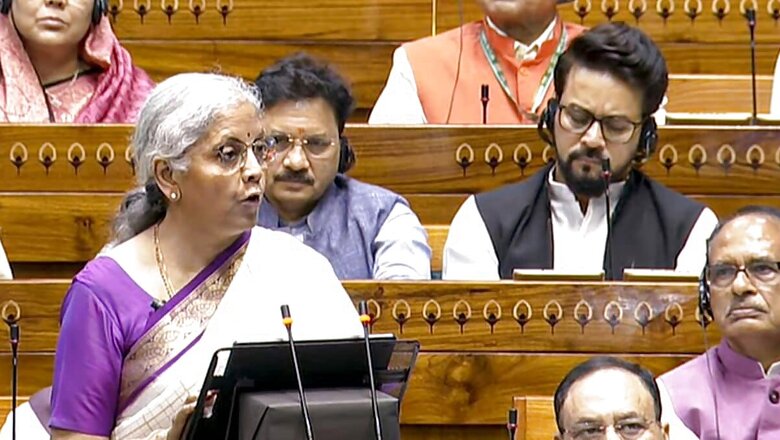
views
The great Indian middle class — a segment that has been traditionally a core vote bank of the Bharatiya Janata Party but partly shifted from the saffron party in many states like Maharashtra, Uttar Pradesh, and West Bengal in the Lok Sabha elections — forced the BJP to reconsider its strategy. What makes the situation more complicated are the various substrata within — the lower and upper middle classes.
Hence, there were a lot of expectations from union finance minister Nirmala Sitharaman’s budget speech this time to woo them back. How far did she manage to do it?
Tax cuts and exemptions
One of the prime concerns of the salaried middle class is some reprieve in income tax. The minister announced several tax measures in the budget this year, including for income tax slabs and a hike in the standard deduction limit under the new regime.
While those earning between Rs 6- 9 lakh were paying 10% according to the new tax regime, the rejigged tax slab makes those earning Rs 7-Rs 10 lakh eligible to pay 10% tax. So those previously in the earning bracket of Rs 6-Rs 7 lakh per annum and Rs 9-Rs 10 lakh per annum get a reprieve.
However, apart from that particular earning segment, very few are to benefit. Those who earn annually above Rs 10 lakh, don’t stand to get any tax reprieve as the new tax regime and the rejigged slabs remain the same.
The government though raised the standard deduction under the new tax regime to Rs 75,000 from Rs 50,000, bringing cheer to salaried taxpayers as well as pensioners.
One thing is very clear — the government is trying to make the new tax regime attractive. Probably that’s why the deduction will remain unchanged at Rs 50,000 under the old one. For family pensioners, the deduction will go up from Rs 15,000 to Rs 25,000 — but again, under the new regime.
For salaried individuals, the government proposes enhanced social security through the deduction of expenditure by employers towards NPS from 10% to 14%.
Should the middle class be happy? “As a result, a salaried individual in the new tax regime stands to save Rs 17,500 in income tax,” Sitharaman said.
Other budget benefits
In spite of mutual funds and stock market investments, a large section of the Indian middle class prefers to invest the old-fashioned way — buying gold ornaments. Also, it purchases gold and silver in large quantities during marriage seasons.
Gold holds immense cultural and traditional significance in states like Kerala. It’s deeply embedded in the lifestyle and customs of the people, particularly during festivals and weddings.
In what may bring cheer to that segment, customs duty on gold and silver has been reduced to 6%, from 10%.
The budget also cut duties on mobile phones, printed circuit board assemblies (PCBAs), and chargers to 15%, reducing even Pro model Apple iPhone prices as well as basic ones. In a nation that had a whopping 1.2 billion mobile phone users in 2022, its largest consumer — the middle class — is bound to be excited.
While the government has proposed to cut customs duty on manufacturing leather and footwear as well, it is yet to be seen how much of the benefits are passed on to the consumer and whether it’s significant. But what will remain important for the middle class like any strata of society is the government’s decision to slash the prices of three more cancer treatment drugs, which are now exempted from customs duty.
What will appeal to the middle class is the government trying to address a key concern — unemployment. Sitharaman has announced the Prime Minister’s package of five schemes and initiatives for addressing unemployment, skilling, and other opportunities for 4.1 crore youth over five years.
The first scheme is for first-timers entering the formal sector whom the government will provide one month’s wage. The second is for job creation in manufacturing where the Narendra Modi government will provide incentives directly to the employee and the employer concerning their EPFO contribution in the first four years. The government has other packages like reimbursing employees getting up to Rs 1 lakh per annum salary and providing skilling to 20 lakh youth over five years to make them job-ready among others.
The government has also decided to enhance the limit of Mudra loans from Rs 10 lakh to RS 20 lakh as well as abolishing the angel tax to boost start-ups, which will benefit the middle class.
The PM said this budget will give “unprecedented opportunities” to people. But has it been able to convince the disenchanted middle class? Upcoming assembly elections in Maharashtra, Haryana, and Jharkhand will give a glimpse of it.
















Comments
0 comment